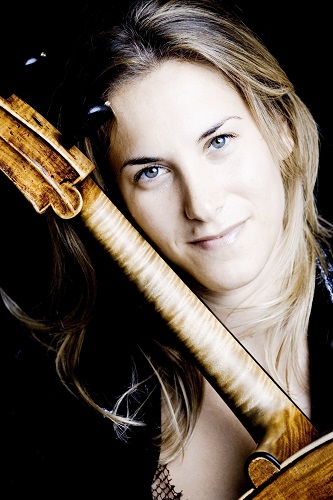 United Kingdom Martinů, Shostakovich, Dvořák, Rachmaninov: Gemma Rosefield (cello) & Katya Apekisheva (piano), Kings Place, London, 18.2.2018. (CS)
United Kingdom Martinů, Shostakovich, Dvořák, Rachmaninov: Gemma Rosefield (cello) & Katya Apekisheva (piano), Kings Place, London, 18.2.2018. (CS)

Martinů – Variations on a Slovak Theme H.378
Shostakovich – Cello Sonata in D minor Op.40
Dvořák – Silent Woods Op.68 No.5
Rachmaninov – Cello Sonata in G minor Op.19
Last week’s London Chamber Music Society Sunday recital at Kings Place was a Slavic feast. Cellist Gemma Rosefield and pianist Katya Apekisheva offered four works which embraced a panoply of Slavonic sentiments and discourses, from elegy to ebullience, regret to rhapsody.
Rosefield has an exemplary technique and one can almost ‘feel’ her physical, intellectual and musical ‘apparatus’ exerting control over the musical material as it unfolds. That’s not to suggest that her playing lacks musicality or feeling; quite the opposite, although there were moments in this recital when I’d have liked a little more spontaneity to balance her unwaveringly accomplishment. She and pianist Apekisheva seemed perfectly attuned and obviously enjoyed each other’s musical company. I’m not sure about the wisdom of raising the piano lid to its full extent though, particularly as Rosewell positioned herself stage-right with her cello angled to her right; seated on the other side of Hall One I found that there were times when Rosefield’s very clean and focused tone did not project fully through Apekisheva’s dramatic and intense accompaniments.
Each half of the recital started with a short work prefacing a more substantial sonata. Martinů was terminally ill when he wrote the Variations on a Slovak Theme in 1959, and perhaps one sensed a poignant urgency as Apekisheva’s sweeping flourishes heralded the folk-drenched theme and five variations which unfold without pause – and, here, with unforced fluency and feeling. Perhaps the rhythmic flexibility of the theme might have been more emphatic and, as we proceeded through the variations, Rosefield did not garner as much variety of colour as Apekisheva. But, her intonation was flawless, and I admired the way Rosefield moved from eloquence to energy in the first variation (Moderato), and made the double stops sing in the ensuing Poco Allegro. In the final variation (Allegro), Apekisheva’s pianistic power was answered by percussive cello pizzicatos, the last gasps of the theme adding sentiment to the drama.
After the interval it was Dvořák who got proceedings underway. The extended phrases of Silent Woods – which began life as one of six pieces for piano duet (From the Bohemian Forest, 1884), was arranged in 1892 for cello and orchestra and subsequently heard in 1894 in a version for cello and piano – allowed Rosefield to indulge her beautiful and sustained cantabile tone. While. once again, the delivery was unforced, the melodism was strong, even in the quietest moments, and contrast was provided by the spirited central section.
Although in these short works the duo’s playing was heartfelt, the sense that they were a ‘warm-up’ for the substantial sonatas which followed was not entirely overcome. Rosefield offered quite an introspective reading of Shostakovich’s 1934 Cello Sonata, the crafting of the melodies surprisingly careful and decorous at times, though always well-considered and assured. At the start of the Allegro non troppo her sound was quite contained, though sweet, and while a marked accelerando established strong momentum, I’d have liked even darker, deeper colours from the cello to match Apekisheva’s striking definition and power. In the second subject, the instruments’ discourse was winningly unified though, the piano’s lucidity answered by the cello’s cool purity. The scherzo set off at a wild tempo, which was exciting but did not quite allow space for the biting accents in the cello’s driving wail to register their full venom. After the whirlwind of sarcasm and fury, in the Largo both players offered a salving delicacy though the restatement of the theme might have been more intensely emphatic. The final Allegro saw Rosefield let herself off the leash a little, as she enjoyed the diversity of the cello’s utterances and articulations – and offered a masterclass in bowing techniques! Here, wry restraint and unrestrained rage were integrated with intelligence and musicianship.
It was in the final work, Rachmaninov’s Cello Sonata of 1901, that Rosefield found her most natural home. Although she did not exploit all the potential rhetoric of the opening Lento, the Allegro moderato had a wonder sense of freedom and propulsion. Apekisheva avoided saccharinity in the second subject, sustaining the forward movement, and the rapid passagework and figures flew with light-fingered grace. The juxtaposition of gruffness and lyricism in the Allegro scherzando was well-negotiated by Rosefield; I thought that she might have given the singing episodes a tad more space to breathe, and was thus surprised when, at the recapitulation, the tempo seemed to have relaxed a little, losing some of the initial tautness. After a wonderfully poised Andante, in which both players exploited Rachmaninov’s sentiment judiciously and with heart-winning beauty and accord, the joyous of the final Allegro mosso brought warm smiles to the faces of both the performers and audience.
I would very much like to hear both Rosefield and Apekisheva perform again, individually or as a duo, particularly in sonatas by Beethoven and perhaps Brahms. They share musical tastes and their temperaments offer an audience both concordance and pleasing contrast.
Claire Seymour